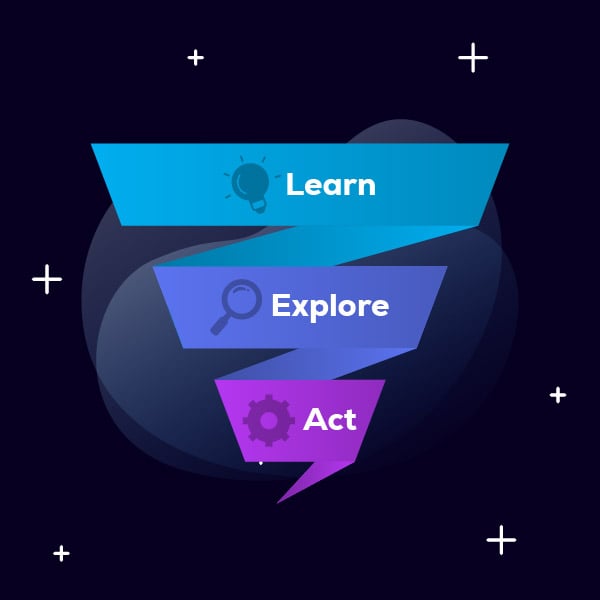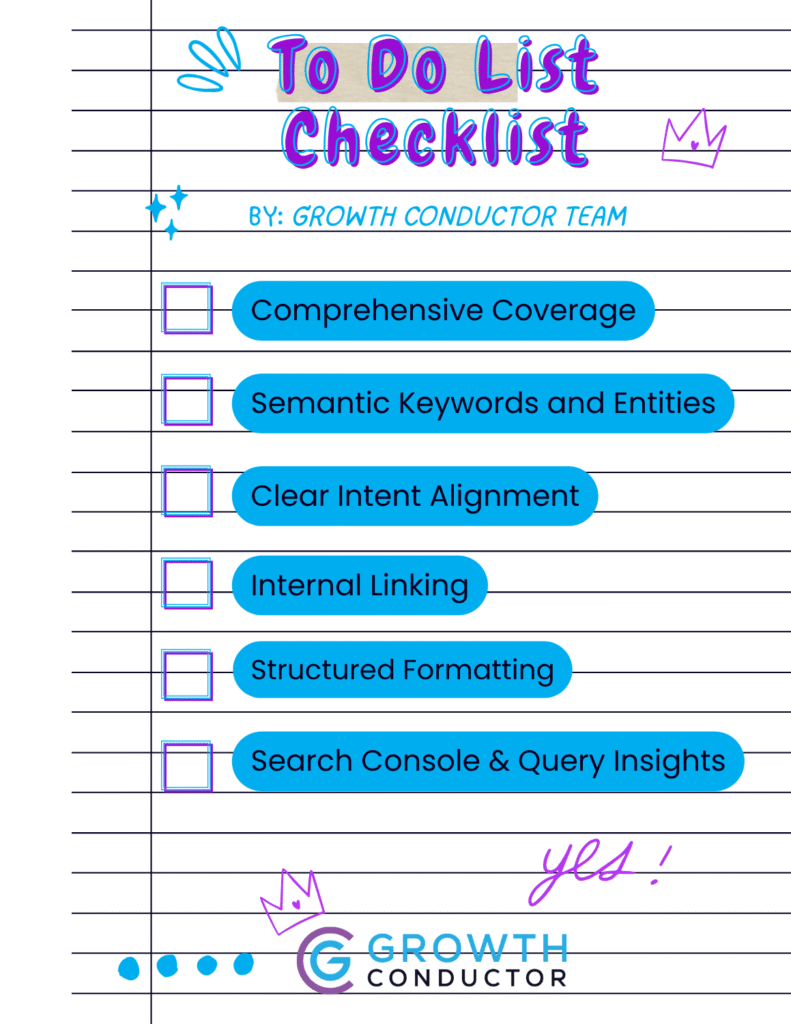Introduction — Why Topical Relevance Matters in 2025
Search engines and AI models now prioritize more than just keywords — they prioritize value. In today’s landscape, creating content that is truly useful, complete, and strategically structured is the key to visibility.
“Topical relevance isn’t just about SEO — it’s about creating content so valuable, complete, and connected that it earns both trust and visibility.”
Topical relevance is how search engines and AI understand that your content belongs to a broader, meaningful subject. It’s not about tricking algorithms — it’s about proving authority through well-connected, in-depth content that solves real problems for your audience.
In this guide, we’ll show you how to create content that ranks because it deserves to — by being strategically structured, aligned with user intent, and designed to serve. You’ll also learn how to build content ecosystems that perform across organic search, AI overviews, and user journeys. At Growth Conductor, we help brands build smarter, value-driven content strategies. Let’s dive in.
What Is Topical Relevance in SEO?
Topical relevance in SEO refers to how well your content aligns with and supports a broader subject area. Unlike traditional keyword optimization — which focuses on matching exact phrases — topical relevance signals to search engines that your content deeply understands and contributes to a complete conversation around a topic.
Think of it this way: keywords are entry points, but topical relevance is the conversation. When your content answers related questions, uses contextually connected language, and supports surrounding subtopics, it tells Google and AI models that your content is credible, complete, and worth ranking.
Search engines like Google use natural language processing (NLP) and entity recognition to determine if your content is genuinely helpful or just surface-level. That’s why content that is deeply connected to a specific theme — and supported by internal linking, semantic keywords, and clear structure — tends to outperform isolated posts or shallow keyword-driven pages. Whether you’re building pillar pages, product content, or blog posts, topical relevance is now the backbone of organic visibility. And it’s not just for SEO — platforms like ChatGPT, Bing CoPilot, and Google’s AI Overviews are also favoring topic-rich content in their summaries.
How Search Engines Interpret Content Depth and Relevance
Search engines have moved far beyond keyword matching. Today, they use advanced natural language processing (NLP) and machine learning models to interpret how well your content aligns with a user’s intent — and how comprehensively it addresses a topic.
This is where content depth and relevance come into play.
When Google evaluates your content, it’s not just looking for a keyword match — it’s analyzing the relationships between entities, the semantic structure of your writing, and how effectively your content fits within the context of your website’s topical authority.
Content that performs well typically includes:
- Comprehensive coverage of a topic, not just one angle
- Internal links to related pages that reinforce the theme
- Natural use of semantically related keywords (also known as LSI keywords or entities)
- Clear, structured formatting that helps AI interpret sections and hierarchy
For example, if you’re writing about “email marketing,” topically relevant content would also address related concepts like automation, segmentation, campaign metrics, and deliverability — not just the basics.
Additionally, AI-powered systems like ChatGPT and Google SGE look for signal-rich content — meaning it’s well-structured, frequently referenced, and part of a larger, consistent narrative across your site.
If your content lacks depth or skips related subtopics, it risks being ignored entirely in favor of more authoritative, better-connected pages.
Creating truly helpful content is no longer optional — it’s the baseline for showing up in AI-powered search results.
The Anatomy of Topically Relevant Content
Topically relevant content isn’t an accident — it’s a system. The most effective pages follow a clear structure that signals expertise, intent alignment, and subject mastery.
Here’s what separates topically relevant content from average content:
1. Comprehensive Topic Coverage
Cover the full scope of a topic — not just a sliver. This includes addressing core ideas, related subtopics, user questions, and decision-making factors. AI models reward content that answers more than just “what” and digs into the “how,” “why,” and “what’s next.”
2. Internal Linking to Contextual Pages
Linking to related articles, services, or tools on your site helps build semantic context and strengthens your site’s overall topical authority. Internal links also guide users and bots to deeper insights.
3. Use of Semantic Keywords and Entities
Incorporate naturally related terms and named entities (brands, tools, places, people) to help search engines understand the full subject landscape. Use tools like Clearscope, Surfer, or Google NLP API to identify what’s missing.
4. Clear Structure and Formatting
Use headings, subheadings, bullet points, and schema markup to create a scannable, digestible experience. Proper formatting helps AI parse sections for snippet generation and voice assistants. At Growth Conductor, we design every piece of content to include these structural signals — building systems that compound visibility, not just posts that rank once and fade.
“Great content is built — not just written.” – Heather
Topic Clusters & Content Hubs — Your Relevance Foundation
If topical relevance is the goal, then topic clusters and content hubs are the blueprint.
Search engines evaluate how well your content fits within a broader subject area. When your content is scattered, shallow, or disconnected, it sends weak signals. But when it’s organized into structured topic clusters, it becomes clear to both users and search engines that your website is a trusted source.
A topic cluster includes:
- A core piece of pillar content: A comprehensive guide or landing page targeting a high-level keyword
- Supporting cluster content: Articles or resources that dig into related subtopics
- Strategic internal linking: Every cluster piece links to the pillar page and to other related articles, forming a web of relevance
This structure improves crawlability, semantic depth, and user experience — and it boosts rankings not just for individual pages, but across your entire domain.
AI overviews, like those from Google SGE, are more likely to feature content that sits within a clear knowledge hierarchy. When a page is connected to related subtopics and supported by a content hub, it becomes more trustworthy in the eyes of AI models. At Growth Conductor, we specialize in building topic cluster frameworks that scale. Whether you’re starting from scratch or restructuring existing content, clusters are the foundation for long-term authority.
“Content isn’t king — context is.” – Heather

How to Identify Gaps in Your Topic Coverage
Even if you’re producing content regularly, that doesn’t guarantee your topic is fully covered. Many websites suffer from coverage gaps—unanswered questions, missed subtopics, or weak internal links that dilute their authority in search.
To improve your topical relevance, you first need to identify what’s missing.
Here are a few reliable methods:
1. Use Google Search Console and Analytics
Look at queries your pages are appearing for but not ranking well. This often reveals content that’s not fully satisfying user intent.
2. Analyze ‘People Also Ask’ and Related Searches
Google’s own search features offer a goldmine of subtopics. Use these questions to guide future blog posts, FAQs, or content updates.
3. Run NLP-Based Content Audits
Tools like Semrush, Surfer SEO, and Clearscope now offer NLP-driven suggestions that identify missing semantically related terms, subtopics, and entities based on the top-ranking content for your target keyword. These audits help uncover what’s missing at both the keyword and topical level.
4. Map the Content Cluster
Visualize your topic cluster. Does each supporting piece link to the core pillar? Are there multiple articles addressing different angles of the same subject?
A content gap isn’t a failure — it’s an opportunity. When you systematically fill these gaps, you not only improve rankings, but also become the go-to source in your niche.

Identifying these content gaps is a critical step in strengthening your site’s topical authority — but the process can be complex. At Growth Conductor, we work with clients to organize and optimize their content libraries using proven topic clustering and semantic structuring methods. Whether you’re missing key subtopics, struggling with internal links, or unsure what Google sees as relevant, we help simplify the process and align your content with how search and AI engines evaluate expertise.
Creating Content That Aligns with Search Intent
Topical relevance means very little if your content doesn’t align with search intent. You could cover all the right subtopics, but if you’re not meeting the reason behind the search — your content won’t rank, convert, or get featured in AI overviews.
Search intent typically falls into three main categories:
1. Informational Intent
The user is looking to learn. Content should provide value quickly with definitions, how-tos, comparisons, and answers to commonly asked questions. This is where guides, glossaries, and educational articles thrive.
2. Navigational Intent
The user is trying to find a specific brand, tool, or resource. Your content should clearly present your solution and make it easy to access — such as service pages, landing pages, or branded blog content.
3. Transactional or Commercial Intent
The user is ready to take action — book, buy, or inquire. Pages here should focus on benefits, proof, and conversion pathways: think sales pages, use-case content, testimonials, and product comparisons.
To create truly topically relevant content, each page must serve a clear purpose in the user journey, and all supporting content should link together to support that stage. AI and search engines are increasingly evaluating content based on how well it serves the user, not just what it says. At Growth Conductor, we help businesses audit and align their content to the right intent — ensuring your content not only ranks, but performs with purpose.

Measuring Topical Relevance — Tools & KPIs
Topical relevance isn’t just a strategy — it’s measurable. If your content is structured properly, supports key subtopics, and satisfies intent, the results will show in your data.
Here’s how to track whether your content is topically aligned and performing:
1. Engagement & Behavior Metrics
Use tools like Google Analytics or Matomo to track:
- Time on page
- Scroll depth
- Bounce rate
- Internal click-throughs
These metrics indicate if users find your content useful and are exploring related pages — a strong signal that you’re covering a topic thoroughly.
2. Keyword Spread & Query Coverage
In Google Search Console, review the range of queries your content is showing up for. The more semantically varied the queries, the more likely your content is being seen as topically authoritative.
3. NLP and Semantic Coverage Tools
Platforms like Semrush, Surfer SEO, Clearscope, and MarketMuse analyze how well your content covers relevant entities and keywords. Use these tools to:
- Benchmark your content vs. top results
- Spot missing entities or subtopics
- Optimize semantic structure
4. Visibility in AI Overviews and SERP Features
Monitor whether your content appears in:
- AI summaries (Google SGE, Bing CoPilot)
- Featured snippets
- People Also Ask
- FAQ schema or rich results
Showing up in these features means your content is being interpreted as highly relevant — not just technically optimized.
Common Mistakes That Weaken Topical Relevance
Even with the best intentions, it’s easy to create content that looks complete but lacks the structure and depth needed to rank — especially in today’s AI-enhanced search landscape.
Here are some of the most common mistakes that weaken your topical relevance:
1. Writing Around Keywords, Not Topics
Focusing on one keyword per page without exploring supporting ideas or related subtopics limits your authority. Modern SEO rewards topic depth, not just keyword targeting.
2. Ignoring Semantic Signals
If you’re not including related terms, entities, and context-specific phrases, you’re leaving semantic gaps that search engines use to understand relevance. Tools like Clearscope or Semrush can help identify what’s missing.
3. Skipping Internal Linking
Isolated content pieces with no relationship to your other content confuse both users and bots. Without internal links, Google can’t fully understand the scope of your topic expertise.
4. Misaligning Search Intent
Publishing content that doesn’t match the user’s intent — such as pushing sales pages when people are still researching — leads to low engagement and poor rankings.
5. Treating Content as One-Offs
Without a strategy to group content into clusters or hubs, even your best posts may fail to build long-term topical authority. Avoiding these mistakes is critical if you want your content to earn visibility, not just exist online. At Growth Conductor, we help brands audit and restructure their content systems to eliminate these blind spots and improve performance at scale.
Final Checklist — Make Your Content Topically Relevant
Before you hit publish, use this checklist to make sure your content is not just well-written — but topically relevant and structured for success:
- Comprehensive Coverage
Did you cover the main topic and all relevant subtopics, FAQs, and user concerns? - Semantic Keywords and Entities
Are you using related terms and context-rich phrases identified by NLP tools? - Clear Intent Alignment
Does your content match what the user is actually trying to achieve (inform, explore, act)? - Internal Linking
Have you linked to relevant pillar pages and related content to build context? - Structured Formatting
Are you using headings, bullet points, and schema markup to enhance readability and indexing? - Search Console & Query Insights
Have you reviewed what queries your audience is already searching for — and addressed them?

The more boxes you check, the stronger your content’s ability to rank across traditional search and AI-powered platforms. If your team needs support in applying this checklist at scale, Growth Conductor can help build a content system designed for sustainable visibility.
Need Help Making Your Content More Relevant?
Creating topically relevant content that ranks in both traditional search and AI-powered results requires more than good writing — it demands structure, research, and a system that scales. If this feels overwhelming, you’re not alone. At Growth Conductor, we help brands simplify their content systems — from building topic clusters and mapping intent, to optimizing for semantic depth and AI visibility. Whether you’re looking to restructure existing pages, launch a new strategy, or simply validate what you’ve already built, our team can support you with clarity and process.
Common FAQs Regarding Making Content More Relevant
What is topical relevance in SEO?
Topical relevance refers to how well your content aligns with a specific subject area. It means your content covers a topic thoroughly, connects with related ideas, and is seen by search engines as a trusted source within that subject.
Why is topical relevance important for rankings?
Search engines and AI models reward content that demonstrates depth, context, and authority. Topical relevance helps ensure your content appears in AI summaries, featured snippets, and top search results by showing it’s part of a broader, helpful content ecosystem.
How do I improve topical relevance on my website?
Start by creating content clusters, using semantic keywords, and linking related pages. Make sure each piece of content supports a clear user intent and contributes to a central topic hub.
What tools can help measure content relevance?
Tools like Semrush, Surfer SEO, Clearscope, and Google Search Console help identify content gaps, semantic weaknesses, and opportunities to improve topic coverage and user alignment.
Can AI help improve topical relevance?
Yes. AI tools can analyze content structure, suggest related entities, and even surface intent-based keywords you might miss. They’re especially useful for scaling topical research and ensuring semantic depth across your content strategy.
